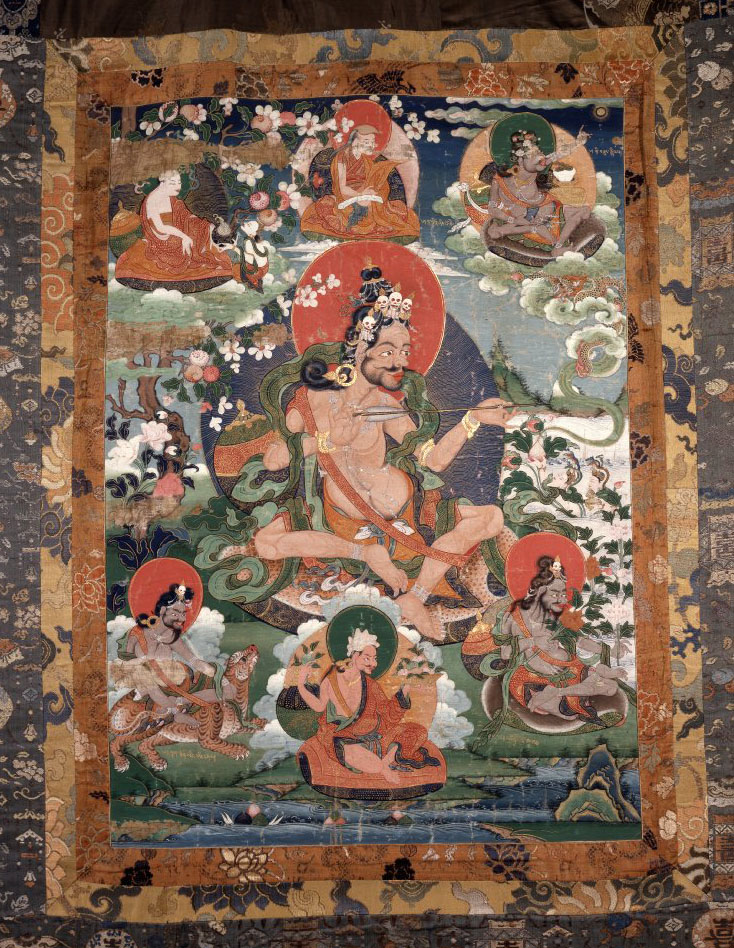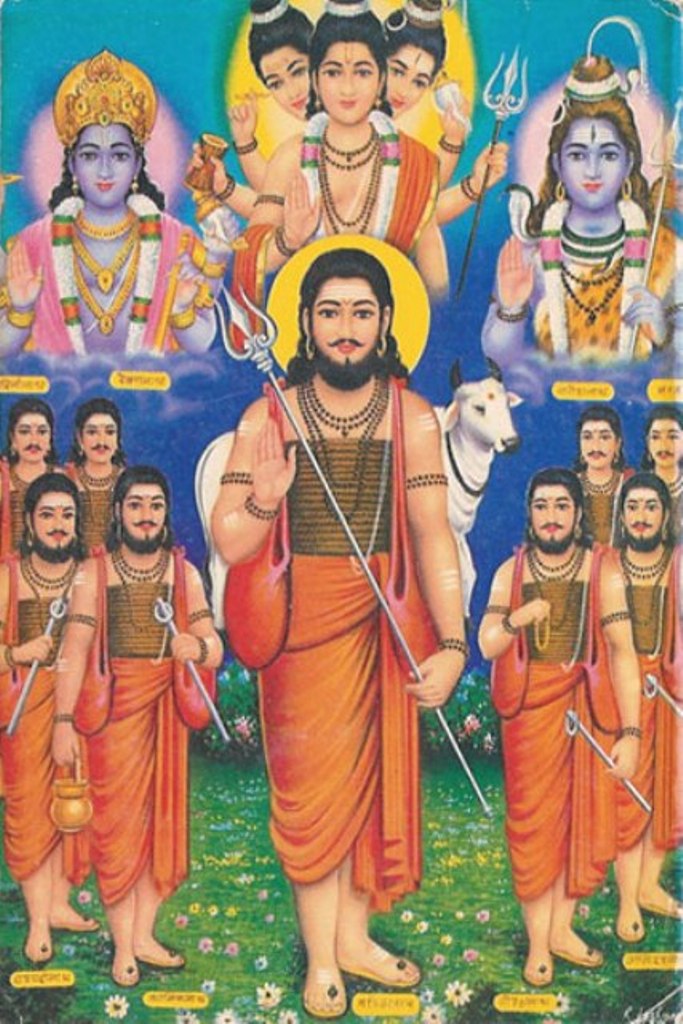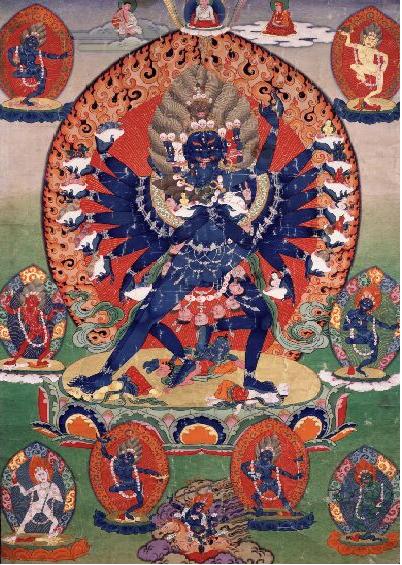|
Sahaja
Sahaja ( ) is spontaneous liberating knowledge in Indian Tantric and Tibetan Buddhist religions. Sahaja practices first arose in Bengal during the 8th century among yogis called Sahajiya siddhas. Ananda Coomaraswamy describes its significance as "the last achievement of all thought", and "a recognition of the identity of spirit and matter, subject and object", continuing "There is then no sacred or profane, spiritual or sensual, but everything that lives is pure and void." Etymology The Sanskrit nd the Tibetan, which precisely follows itliterally means: 'born or produced together or at the same time as. Congenital, innate, hereditary, original, natural (...by birth, by nature, naturally...)'. Etymologically, means 'together with', and derives from the root , meaning 'to be born, produced, to occur, to happen'. The Tibetan is an exact etymological equivalent of the Sanskrit. means 'together with', and means 'to be born, to arise, to come about, to be produced'. The Ti ... [...More Info...] [...Related Items...] OR: [Wikipedia] [Google] [Baidu] |
Mahamudra
Mahāmudrā (Sanskrit: महामुद्रा, , contraction of ) literally means "great seal" or "great imprint" and refers to the fact that "all phenomena inevitably are stamped by the fact of wisdom and emptiness inseparable". Mahāmudrā is a multivalent term of great importance in later Indian Buddhism and Tibetan Buddhism which "also occurs occasionally in Hindu and East Asian Buddhist esotericism." The name also refers to a body of teachings representing the culmination of all the practices of the New Translation schools of Tibetan Buddhism, who believe it to be the quintessential message of all of their sacred texts. The practice of Mahāmudrā is also known as the teaching called " Sahajayoga" or "Co-emergence Yoga". In Tibetan Buddhism, particularly the Kagyu school, Sahaja Mahāmudrā is sometimes seen as a different Buddhist vehicle ( yana), the "Sahajayana" (Tibetan: ''lhen chig kye pa''), also known as the vehicle of self-liberation. Jamgon Kongtrul, a T ... [...More Info...] [...Related Items...] OR: [Wikipedia] [Google] [Baidu] |
Nath
Natha, also called Nath (), are a Shaivism, Shaiva sub-tradition within Hinduism in India and Nepal. A medieval movement, it combined ideas from Buddhism, Shaivism, Tantra and Yoga traditions of the Indian subcontinent.Natha: Indian religious sect Encyclopedia Britannica (2007) The Naths have been a confederation of devotees who consider Shiva as their first lord or guru, with varying lists of additional gurus. Of these, the 9th or 10th century Matsyendranatha and the ideas and organization mainly developed by Gorakhnath are particularly important. Gorakhnath is considered the originator of the Nath Panth. The Nath tradition has an extensive Shaivism-related theological literature of its own, most of which is ... [...More Info...] [...Related Items...] OR: [Wikipedia] [Google] [Baidu] |
Sampradaya
''Sampradaya'' (/ səmpɾəd̪ɑjə/,; ), in Indian-origin religions, namely Hinduism, Buddhism, Jainism, and Sikhism, can be translated as 'tradition', 'spiritual lineage', 'sect', or 'religious system'. To ensure continuity and transmission of dharma, various ''sampradayas'' have the Guru-shishya parampara in which a parampara or lineage of successive ''gurus'' (masters) and '' shishyas'' (disciples) serves as a spiritual channel and provides a reliable network of relationships that lends stability to a religious identity. Shramana is vedic term for seeker or shishya. Identification with and followership of ''sampradayas'' is not static, as ''sampradayas'' allows flexibility where one can leave one ''sampradaya'' and enter another or practice religious syncretism by simultaneously following more than one ''sampradaya''. '' Samparda'' is a Punjabi language term, used in Sikhism, for ''sampradayas''. Guru-shishya parampara Sampradayas are living traditions of both teac ... [...More Info...] [...Related Items...] OR: [Wikipedia] [Google] [Baidu] |
Hevajra
Hevajra ( Tibetan: kye'i rdo rje / kye rdo rje; Chinese: 喜金剛 Xǐ jīngāng / 呼金剛 Hū jīngāng;) is one of the main yidams (enlightened beings) in Tantric, or Vajrayana Buddhism. Hevajra's consort is Nairātmyā ( Tibetan: bdag med ma). History India The Hevajra Tantra, a ''yoginītantra'' of the '' anuttarayogatantra'' class, is believed to have originated between the late 8th (Snellgrove), and the late 9th or early 10th (Davidson), centuries in eastern India, possibly Kamarupa. Tāranātha lists Saroruha and Kampala (also known as Lva-va-pā, Kambhalī, and Śrī-prabhada") as its "bringers": . . . the foremost yogi Virupa meditated on the path of Yamāri and attained siddhi under the blessings of Vajravārāhi, . . . His disciple Dombi Heruka..understood the essence of the Hevajra Tantra, and composed many śāstras like the ''Nairātmā-devi-sādhana'' and the ''Sahaja-siddhi''. He also conferred abhiṣeka on his own disciples. After this, two ācār ... [...More Info...] [...Related Items...] OR: [Wikipedia] [Google] [Baidu] |
Vajrayana
''Vajrayāna'' (; 'vajra vehicle'), also known as Mantrayāna ('mantra vehicle'), Guhyamantrayāna ('secret mantra vehicle'), Tantrayāna ('tantra vehicle'), Tantric Buddhism, and Esoteric Buddhism, is a Mahāyāna Buddhism, Mahāyāna Buddhist tradition that emphasizes Eastern esotericism, esoteric practices and rituals aimed at Sudden awakening, rapid spiritual awakening. Emerging between the 5th and 7th centuries CE in medieval India, Vajrayāna incorporates a Tibetan tantric practice, range of techniques, including the use of mantras (sacred sounds), dhāraṇīs (mnemonic codes), mudrās (symbolic hand gestures), mandalas (spiritual diagrams), and the visualization of Buddhist deities, deities and Buddhahood, Buddhas. These practices are designed to transform ordinary experiences into paths toward Enlightenment in Buddhism, enlightenment, often by engaging with aspects of Taṇhā, desire and Dvesha, aversion in a ritualized context. A distinctive feature of Vajrayāna is ... [...More Info...] [...Related Items...] OR: [Wikipedia] [Google] [Baidu] |
Doha (poetry)
Doha (, , ) is a form of self-contained rhyming couplet in poetry composed in Mātrika metre. This genre of poetry first became common in Apabhraṃśa and was commonly used in Hindustani language poetry. Among the most famous dohas are those of Sarahpa, Kabir, Mirabai, Rahim, Tulsidas, Surdas A doha is a couplet consisting of two lines, each of 24 instants (Matras). The rules for distinguishing light and heavy syllables is slightly different from Sanskrit. Each line has 13 instants in first part and 11 instants in the second. The first and third quarters of doha have 13 instants which must parse as 6-4-3. Many Hindi poets have created several books which explain whole stories and epics in the form of dohas. The most popular is Tulsidas' '' Ramcharitmanas'', a popular rendition of the Sanskrit epic ''Ramayana''. Examples Here is a Doha by Rahim: जो रहीम उत्तम प्रकृति का कर सकत कुसंग। चन्दन विष � ... [...More Info...] [...Related Items...] OR: [Wikipedia] [Google] [Baidu] |
Svecchachara
Svecchācāra (IAST; Sanskrit: स्वेच्छाचार) is an important concept in the Nath Sampradaya. 'Svecchācāra' means: acting as one likes, arbitrariness, acting without restraint. The word appears to be a combination of three Sanskrit words: ''sva'' (self), ''iccha'' (will), and ''cāra'' (deportment), essentially adding up to "behaving as one desires" or "in accordance with one's will (iccha)". John Woodroffe (1951: p. 440) associates it with notions of antinomianism and that it is evident in the Upanishads and Tantras: "Lastly, the doctrine that the illuminated knower of Brahman (Brahmajnani) is above both good (Dharma) and evil (Adharma) should be noted. Such a one is a Svechacari whose way is Svechacara or "do as you will". Similar doctrine and practices in Europe are there called Antinomianism. The doctrine is not peculiar to the Tantras. It is to be found in the Upanishads, and is in fact a very commonly held doctrine in India." Woodroffe (1951: pp ... [...More Info...] [...Related Items...] OR: [Wikipedia] [Google] [Baidu] |
Pala Empire
The Pāla Empire was the empire ruled by the Pala dynasty, ("protector" in Sanskrit) a medieval Indian dynasty which ruled the kingdom of Gauda Kingdom, Gauda. The empire was founded with the election of Gopala, Gopāla by the chiefs of Kingdom of Gauda, Gauda in late eighth century CE. The Pala stronghold was located in Bengal and eastern Bihar, which included the major cities of Gauḍa (city), Gauḍa, Bikrampur, Vikramapura, Pataliputra, Pāṭaliputra, Munger, Monghyr, Somapura, Ramavati (Varendra), Tamralipta, Tāmralipta and Jaggadala, Jagaddala. The Pālas were astute diplomats and military conquerors. Their army was noted for its vast war elephant corps. Their navy performed both mercantile and defensive roles in the Bay of Bengal. At its zenith under emperors Dharmapala (emperor), Dharmapala and Devapala (Pala dynasty), Devapala in the early ninth century, the Pala empire was the dominant power in the northern Indian subcontinent, with its territory stretching across ... [...More Info...] [...Related Items...] OR: [Wikipedia] [Google] [Baidu] |
Tantric Sex
Tantric may refer to: Religion Religious practices * Tantra massage, a form of erotic massage * Tantric sex, Hindu and Buddhist tantric practices that utilize sexual activity in a ritual or yogic context * Tantric yoga, a form of yoga * Tibetan tantric practice, Tibetan Buddhist tantric practices Religious texts * Buddhist tantric literature, esoteric Buddhist texts * Hindu tantric literature, esoteric Hindu texts Religious traditions * Tantra, a Hindu and Buddhist esoteric tradition * Neotantra, a New Age practice *Vajrayana ''Vajrayāna'' (; 'vajra vehicle'), also known as Mantrayāna ('mantra vehicle'), Guhyamantrayāna ('secret mantra vehicle'), Tantrayāna ('tantra vehicle'), Tantric Buddhism, and Esoteric Buddhism, is a Mahāyāna Buddhism, Mahāyāna Buddhis ..., an Indian and Tibetan Buddhist trantric tradition Music * Tantric (band), an American rock band ** ''Tantric'' (album), a 2001 album by Tantric See also * Tantra (other) {{disambiguation ... [...More Info...] [...Related Items...] OR: [Wikipedia] [Google] [Baidu] |
Ganachakra
A ganacakra ( ' "gathering circle"; ) is also known as tsok, ganapuja, cakrapuja or ganacakrapuja. It is a generic term for various tantric assemblies or feasts, in which practitioners meet to chant mantra, enact mudra, make votive offerings and practice various tantric rituals as part of a ''sādhanā'', or spiritual practice. The ganachakra often comprises a sacramental meal and festivities such as dancing, spirit possession, and trance; the feast generally consisting of materials that were considered forbidden or taboo in medieval India like meat, fish, and wine. As a tantric practice, forms of gaṇacakra are practiced today in Hinduism, Bön and Vajrayāna Buddhism. Professor Miranda Shaw summarises the experience of a ''gaṇacakra'': Samuel holds that: Origins John Woodroffe (writing as Arthur Avalon, 1918) affirms that the panchamrita of Tantra, Hindu and Buddhist traditions are directly related to the Mahābhūta or Five Elements and that the panchamakara is ... [...More Info...] [...Related Items...] OR: [Wikipedia] [Google] [Baidu] |





